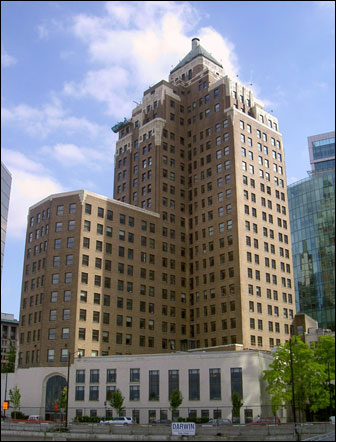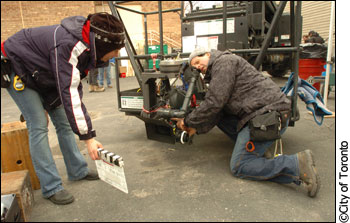Tags
Related Posts
Share This
Ontario’s bold gambit for stardom
Flashing lights and sirens fill the screen. SWAT trucks pull up behind the FBI cars. Agents rush into position; they have surrounded the Federal Center Station in Washington D.C., and now we wait. This episode of Fringe has established the suspense it needs to hook in viewers.
The camera pans over to the station and suddenly the show’s illusion of reality shatters. That building is not the Federal Center Station; in fact, it is not even a metro station. It is the Vancouver Art Gallery.

Often seen in downtown Toronto: a film crew setting up a shot.
This type of scene is not uncommon to British Columbia (BC), which often benefits from runaway American projects. The province accounts for 60 per cent of all foreign film and television productions in Canada and follows Los Angeles and New York City as the third largest hub of foreign films in North America, according to the British Columbia Film website. Last year the BC Film Commission reported 14 American television shows in production. These shows spent almost $400 million dollars while shooting in BC.
But lately BC has a challenger: Ontario, which is seeking out its own chunk of foreign productions.
In June 2009, the Ontario government enlarged the Ontario Production Services Tax Credit (OPSTC), raising its tax credits for American productions from 25 per cent of eligible labour to 25 per cent of all Ontario production costs, according to the Ontario Media Development Corporation (OMDC).
These tax credits are issued by provincial governments to foreign or domestic film and television productions that fulfill certain qualifications when it comes to hiring crews and making other expenditures in the respective province. The eligible tax-credit spending is specific to production. (Meanwhile, whenever American crews film in Canada, many other, non-tax-credited dollars get spent—on lodging, food, gas and other necessities—that go fully into the local economy.)
‘The guys in BC have concluded that Ontario is actually losing money.’ – Steve Mitchell
Regarding BC tax credits: “For every BC individual that [the American projects] hire to work on a production, the provincial government will give a tax credit of a certain percentage, depending on what that person is doing and what type of production you’re filming,” says Robert Wong, vice-president of tax credits and development at BC Film.
In Ontario the credit system works almost the same way, except that the province now reimburses any foreign project one quarter of whatever it spends on production within the province; the credit is no longer specific to labour, as in BC. This means that for every dollar an American production spends in Ontario, 25 cents can be reclaimed.
The results of this enhanced tax-credit program were immediate. In that same year, 2009, foreign filmmakers started spending more money in Ontario, leading to a 114 per cent increase in foreign spending in the province.
For example, the OMDC recorded that for American television series alone, spending jumped 262 per cent in 2008–2009, from $16 million in 2008 to $58 million in 2009, despite the number of shot-in-Ontario productions climbing only from five to six. Furthermore, this boom appears to have followed through to the 2010 production year, says George McNeillie of the OMDC.
But this enhancement of tax credits is not necessarily a good thing for the Ontario industry, says Steve Mitchell, president of Vancouver Film Studios.
Too thin a profit margin?
When Ontario first announced its new tax credit program, there was some clamor within the BC film and television industry that Ontario was overtaking BC in competition. However, as Mitchell explains, it soon became evident in BC that increasing its tax credits to match Ontario’s would not have been the right decision for BC.
“At a certain point when you’re giving tax credits, you’re in a negative revenue situation,” Mitchell says. “The guys in BC have concluded that Ontario is actually losing money.”

Superman’s Daily Planet? In the U.S. TV series Smallville, the newspaper office’s exterior is really Vancouver’s Marine Building.
Imagine an American production shooting in Ontario and spending part of its budget on local producers, labour, film labs, etc.; the Americans would be eligible to get back 25 per cent of whatever they spent. If that production spends $50 million in Ontario, it would reclaim $12.5 million under the OPSTC, and Mitchell argues that it is just not worth it.
“We’re just not going to spend money to get these films; we’re going to at least try and recoup our costs,” Mitchell says.
But the OMDC argues that they are not losing money; instead, they have established a supportive and competitive program that, in 2009, contributed almost a billion dollars to the economy.
Both provinces agree on one thing, at least: Tax credits attract revenue to more than just the Ontario or BC film industries. Runaway film productions bring work to all sorts of local businesses; the filmmakers hire carpenters and drivers, stay in hotels, buy food, buy gas and much more. They give local economies a welcome boost. “We really look at it in BC as an industry that puts people into houses and enables them to pay their mortgages,” Mitchell says.
So to some extent, it makes sense for Ontario to stretch to offer competitive tax incentives to attract such business. The question is: to stretch how far?
Despite BC’s criticism of the Ontario program, in March 2010 BC apparently responded by increasing its tax credit from 25 per cent to 33 per cent of labour. The province also implemented an increase to its digital-animation or visual-effects bonus, moving it from 15 per cent to 17.5 per cent. This allows any eligible production that employs visual effects or animation companies from BC to reclaim 17.5 per cent of what is spent, in effect offering a good chance for increased business for BC’s many special-effects companies.
Still, BC’s 33 per cent tax credit is still far below Ontario’s aggregate, since it applies only to labour. Ontario credits apply to all production costs incurred within the province.
High hopes in Ontario
If Ontario’s bold tax-credit program is destined to put Ontario ahead of BC, that outcome is not yet obvious. Simply by turning on the TV, viewers can see that BC is still heavily favoured in regard to American filming. Shows like Fringe, Hellcats and Supernatural are all filmed in Metro Vancouver. Warner Bros.’s Smallville, now on its tenth season, has always been shot there.
Citing company policy, Warner Bros. TV was unable to comment on its business dealings in Canada. But BC’s Mitchell and Wong both point out that BC offers its American TV clients more than just savings.
“BC has some intrinsic, competitive elements that Ontario simply can’t compete with,” Mitchell says. “Our geography is obviously very different; our climate is very different, which suits some shows better than others.”
Yet Ontario may have reason to hope, from such statistics as its aforementioned foreign-television-spending revenue increase of 262 per cent from 2008 to ’09. Although 2010 productivity reports are not available at this writing, the OMDC’s McNeillie, in an email, details some of 2010’s American-TV-series activity in Ontario:

Hogtown plays host: cueing a scene in Toronto
“U.S. television production has been strong with a number of pilots, series and mini-series in production, including: USA Network’s Covert Affairs, the Cartoon Network’s Unnatural History, a re-make of Nikita from Warner Bros. Television; Steven Spielberg, DreamWorks [and] TNT’s new sci-fi series Fallen Skies [and] MTV’s Skins being produced by E1.”
While some in BC say that Ontario is too generous with its new tax-credit program and is essentially paying foreign productions to shoot in the province, McNeillie says that that is just not the case. These tax credits are an important part of Ontario’s toolkit to attract productions, he says.
It is all about offering TV and film producers the right mix of talented crews and actors, state-of-the art studios and infrastructure and, of course, financial incentives.
Front page photo courtesy of the City of Toronto





